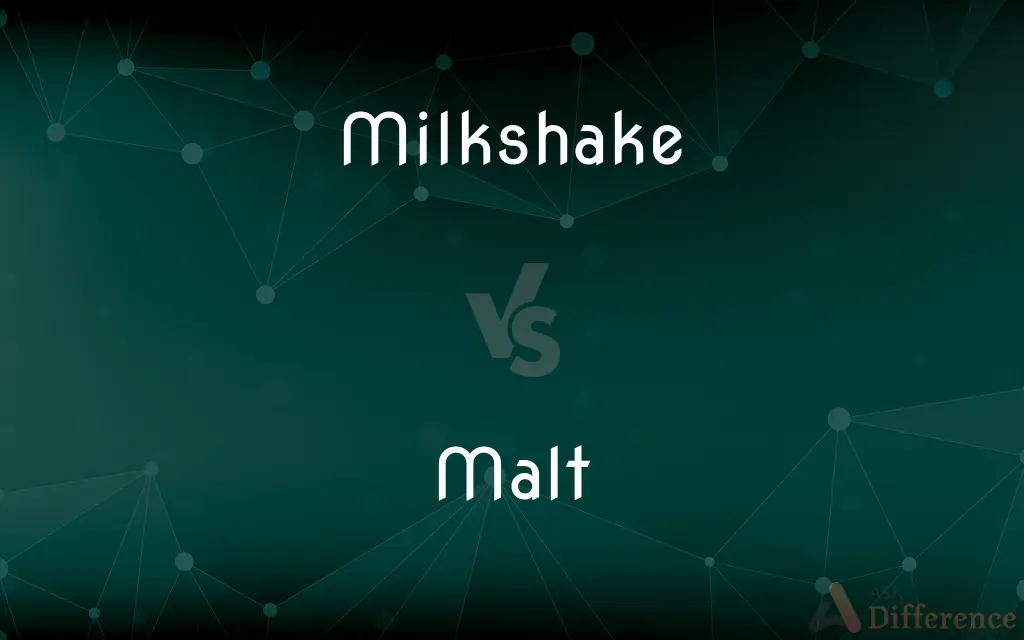Milkshake vs. Malt — What's the Difference?
By Urooj Arif & Fiza Rafique — Updated on March 27, 2024
A milkshake blends milk, ice cream, and flavorings or sweeteners, while a malt, or malted milkshake, includes malted milk powder for a distinct flavor and additional richness.

Difference Between Milkshake and Malt
Table of Contents
ADVERTISEMENT
Key Differences
A milkshake is a popular cold beverage made by blending milk with ice cream and flavorings such as chocolate, vanilla, or fruits to create a smooth, creamy texture. The emphasis is on the combination of dairy and flavors, with potential additions like syrups or whipped cream to enhance taste and texture. On the other hand, a malt, specifically a malted milkshake, builds on the basic milkshake foundation by incorporating malted milk powder, which is made from malted barley, wheat flour, and whole milk powder.
While both beverages are served cold and share a creamy consistency, the key difference lies in the flavor profile. Milkshakes can vary widely in flavor depending on the ingredients used, from simple dairy sweetness to rich, complex blends of chocolate, fruit, and more. Malted milkshakes, however, have a distinct taste due to the malted milk powder, setting them apart from their non-malted counterparts with a unique flavor that many describe as reminiscent of caramel or toffee.
The texture of both drinks is typically thick and smooth, but malted milk powder can add a slightly grainy texture to a malted milkshake, providing a subtle textural contrast to the otherwise creamy beverage. This textural difference is generally mild but noticeable to those familiar with both drinks.
In terms of nutritional content, both milkshakes and malts are high in calories and dairy-based nutrients such as calcium and vitamin D, especially when made with full-fat milk and ice cream. However, the addition of malted milk powder in malts introduces additional carbohydrates and a small amount of protein, slightly altering the nutritional profile compared to a standard milkshake.
Culturally, milkshakes have been a staple of American diners and fast-food restaurants since the early 20th century, symbolizing classic American cuisine. Malted milkshakes share this cultural space but are often associated with a nostalgic appeal, harkening back to the soda fountain culture of the mid-20th century when malted milk was a popular ingredient in sweets and beverages.
ADVERTISEMENT
Comparison Chart
Base Ingredients
Milk, ice cream, sweeteners/flavorings
Milk, ice cream, sweeteners/flavorings, malted milk powder
Flavor
Varies (chocolate, vanilla, fruit, etc.)
Nutty, slightly sweet (from malted milk powder)
Texture
Smooth and creamy
Smooth with a slightly grainy feel from malt
Nutritional Content
High in dairy nutrients, variable sugar
Higher carbohydrates due to malt, slightly more protein
Cultural Significance
American diner classic, versatile
Nostalgic, reminiscent of mid-20th-century soda fountains
Compare with Definitions
Milkshake
A creamy beverage made with milk and ice cream.
She ordered a strawberry milkshake.
Malt
A milkshake with the addition of malted milk powder.
She prefers the rich flavor of a chocolate malt.
Milkshake
Often flavored with syrups or fruit.
His favorite is a chocolate milkshake.
Malt
Evokes nostalgia for the soda fountain era.
Ordering a malt takes him back to his youth at the soda fountain.
Milkshake
Can be made in a variety of flavors.
The cafe offers mango and raspberry milkshakes.
Malt
Has a distinct nutty and sweet flavor.
The caramel malt is their specialty.
Milkshake
Served cold, usually with whipped cream on top.
They enjoyed vanilla milkshakes with extra whipped cream.
Malt
Often associated with a slightly grainy texture.
The malted milk gives the shake a unique texture.
Milkshake
A staple in diners and fast-food menus.
The diner is famous for its thick, homemade milkshakes.
Malt
Richer and slightly more nutritious than a regular milkshake.
Malted milkshakes offer a bit more protein.
Milkshake
A milkshake (sometimes simply called a shake) is a sweet drink made by blending milk, ice cream, and flavorings or sweeteners such as butterscotch, caramel sauce, chocolate syrup, fruit syrup, or whole fruit into a thick, sweet, cold mixture. It may also be made using a base made from non-dairy products, including plant milks such as almond milk, coconut milk, or soy milk.
Malt
Malt is germinated cereal grain that has been dried in a process known as "malting". The grain is made to germinate by soaking in water and is then halted from germinating further by drying with hot air.Malting grain develops the enzymes (α-amylase, β-amylase) required for modifying the grains' starches into various types of sugar, including monosaccharide glucose, disaccharide maltose, trisaccharide maltotriose, and higher sugars called maltodextrines.
Milkshake
A cold drink made of milk, a sweet flavouring such as fruit or chocolate, and typically ice cream, whisked until it is frothy.
Malt
Grain, usually barley, that has been allowed to sprout, used chiefly in brewing and distilling.
Milkshake
A beverage that is made of milk, ice cream, and often flavoring and is blended or whipped until foamy. Also called shake; also called regionally cabinet, frappe, velvet.
Malt
An alcoholic beverage, such as beer or ale, brewed from malt.
Milkshake
New England A beverage made of milk and flavored syrup, whipped until foamy.
Malt
See malted milk.
Milkshake
A thick beverage consisting of milk and ice cream mixed together, often with fruit, chocolate, or other flavoring.
Malt
To process (grain) into malt.
Milkshake
A thin beverage, similar to the above, but with no ice cream or significantly less of it.
Malt
To treat or mix with malt or a malt extract.
Milkshake
A beverage consisting of fruit juice, water, and some milk, as served in Southeast Asia.
Malt
To become malt.
Milkshake
Accidental emulsion of oil and water in an engine.
This milkshake under the oil cap, or on the dipstick, indicates a blown head gasket.
Malt
Malted grain sprouted grain (usually barley), used in brewing and otherwise.
Milkshake
An alkaline supplement administered to a horse to improve its racing performance.
Malt
Malt liquor, especially malt whisky.
Milkshake
To administer an alkaline supplement to (a horse) to improve its racing performance.
Malt
A milkshake with malted milk powder added for flavor.
Milkshake
To throw a milkshake at (a person).
A politician was milkshaked during the protest.
Malt
Maltose-rich sugar derived from malted grain.
Milkshake
A frothy drink of milk and flavoring and sometimes fruit or ice cream, shaken together or blended in a blender.
Malt
(transitive) To convert a cereal grain into malt by causing it to sprout (by soaking in water) and then halting germination (by drying with hot air) in order to develop enzymes that can break down starches and proteins in the grain.
Milkshake
Frothy drink of milk and flavoring and sometimes fruit or ice cream
Malt
(intransitive) To become malt.
Malt
To drink malt liquor.
Malt
Barley or other grain, steeped in water and dried in a kiln, thus forcing germination until the saccharine principle has been evolved. It is used in brewing and in the distillation of whisky.
Malt
Relating to, containing, or made with, malt.
Malt
To make into malt; as, to malt barley.
Malt
To become malt; also, to make grain into malt.
Malt
A milkshake made with malt powder
Malt
A lager of high alcohol content; by law it is considered too alcoholic to be sold as lager or beer
Malt
A cereal grain that is kiln-dried after having been germinated by soaking in water; used especially in brewing and distilling
Malt
Treat with malt or malt extract;
Malt beer
Malt
Turn into malt, become malt
Malt
Convert grain into malt
Malt
Convert into malt
Common Curiosities
Are malts thicker than milkshakes?
The thickness is generally similar, though the presence of malted milk powder can alter the texture slightly.
Why do malts taste different from milkshakes?
The malted milk powder adds a unique flavor profile that is nutty and sweet, distinguishing it from the broader range of milkshake flavors.
Is there a significant nutritional difference between a milkshake and a malt?
Malts have a bit more carbohydrates and protein due to the malted milk powder, but both are high in sugar and dairy nutrients.
Can people with dairy allergies enjoy milkshakes or malts?
Dairy-free versions can be made with alternatives like almond milk and vegan ice cream, though traditional recipes are dairy-based.
How have milkshakes and malts evolved over time?
Both have seen variations in ingredients and flavors, with trends towards gourmet and specialty options expanding their traditional definitions.
What's the best way to make a malt at home?
Blend your choice of ice cream and milk with a generous scoop of malted milk powder and any additional flavorings.
Do milkshakes and malts have different origins?
Both share a similar history, with malts emerging as a variation of the milkshake popularized in early 20th-century America.
What is malted milk powder?
Malted milk powder is made from malted barley, wheat flour, and whole milk, dried and ground into a powder, known for its sweet, nutty flavor.
Can milkshakes and malts be considered a meal replacement?
While they can be filling, they're typically high in sugar and should be enjoyed as a treat rather than a meal replacement.
How do fast-food restaurants differ in their milkshake and malt offerings?
Fast-food chains often offer a range of milkshake flavors, but malts might be less commonly found and cherished for their nostalgic value.
Can any milkshake be made into a malt?
Yes, by adding malted milk powder to the ingredients of a traditional milkshake, it becomes a malt.
Where can I find malted milk powder?
It's available in many grocery stores, near the baking ingredients or powdered milk.
What are some popular milkshake and malt flavors?
Classic flavors include chocolate, vanilla, and strawberry, with malts often highlighting the malt flavor alongside these bases.
Are milkshakes and malts popular worldwide?
Milkshakes enjoy widespread popularity, while malts are more closely associated with American cuisine but have fans globally.
Share Your Discovery

Previous Comparison
Believable vs. Plausible
Next Comparison
Jaguar vs. PantherAuthor Spotlight
Written by
Urooj ArifUrooj is a skilled content writer at Ask Difference, known for her exceptional ability to simplify complex topics into engaging and informative content. With a passion for research and a flair for clear, concise writing, she consistently delivers articles that resonate with our diverse audience.
Co-written by
Fiza RafiqueFiza Rafique is a skilled content writer at AskDifference.com, where she meticulously refines and enhances written pieces. Drawing from her vast editorial expertise, Fiza ensures clarity, accuracy, and precision in every article. Passionate about language, she continually seeks to elevate the quality of content for readers worldwide.












































